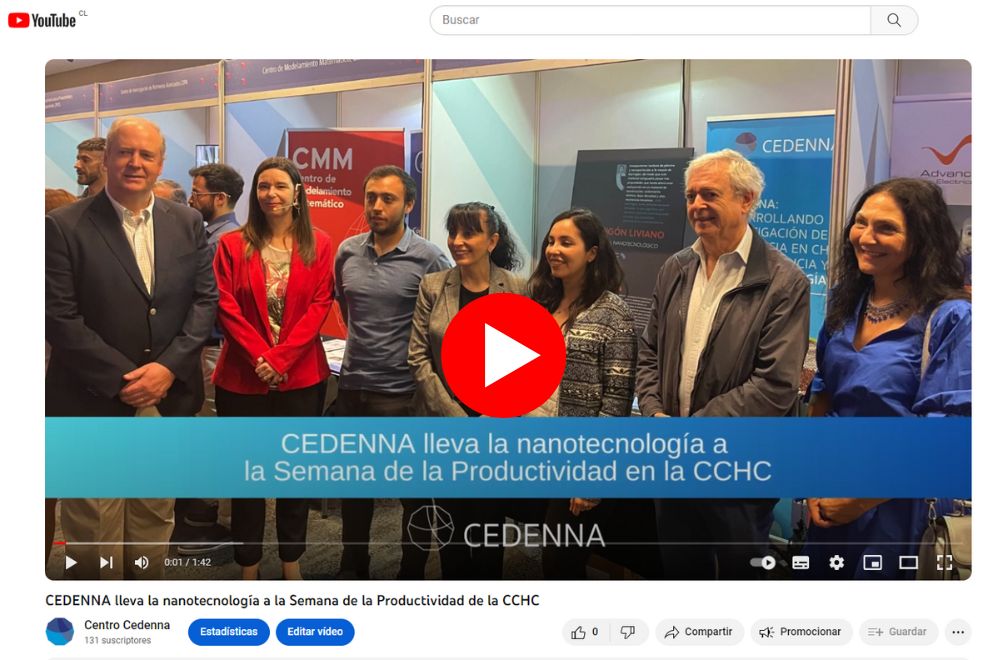
With nanotechnological concrete and measurement of risks associated with particulate materials in suspension in construction environments, the stand of the Center for Nanoscience and Nanotechnology, CEDENNA, aroused the interest of those attending the last day of the third version of Productivity Week, organized by the Chilean Chamber of Construction (CChC), in alliance with the National Research and Development Agency (ANID).
Helen Ipinza Wolff, head of the Department of Initiatives Oriented to Development and Innovation at ANID, highlighted the importance of this day in which 11 research centers participated: “Our objective is to awaken a productive link between the industry and our researchers, so that we can "to contribute from science with innovative scientific-based solutions and take charge of the great challenges that are becoming more complex every day,"
He added that CEDENNA, with its advances in nanotechnological concrete and nanoparticles, is a clear example of how nanoscience can improve aspects such as thermal insulation and health aspects. "But, just like that, there are other great opportunities that are opening up because CEDENNA has shown to have a very powerful team to make technological developments based on nanotechnology and nanoscience," he said.
Mariela Muñoz, Leader of Human Capital and Academia at the Technological Development Corporation (CDT) of the Chilean Chamber of Construction, highlighted that cooperation with ANID and centers such as CEDENNA is crucial to understand how nanotechnology can improve productivity and sustainability in the construction. "CEDENNA has proven to be a leader in the development of nanotechnological concrete and other innovative products that transform waste into valuable productive processes," he said.
At the center's stand, Dr. Mauricio Escudey, director of CEDENNA's Nanosafety Unit, explained that on this occasion emphasis was placed on the center's ability to perform crucial measurements in construction, especially in monitoring and risk management. associated with particulate matter in suspension.
“What we are showing on this occasion - commented the researcher - is how we can measure, how we can quantify the size of that particulate material and the risks that may be associated with that. With that information, we can link the level and quality of protection that those who are working in the environment where all that movement is taking place should have.”
Nanotechnology concrete
Nanotechnological concrete, an innovation presented at Productivity Week by the Center for Nanoscience and Nanotechnology, is the result of extensive research led by Dr. Roberto Lavín, scientist at the center and Director of the Institute of Basic Sciences of the Universidad Diego Portals (UDP).
This development not only represents a breakthrough in construction, but also exemplifies the transformative potential of nanotechnology in industry. The research of Dr. Lavín and his team has allowed the creation of a material that redefines the limits of traditional concrete, promoting more effective and environmentally sustainable solutions.
Characteristics:
- Structural insulation: This concrete meets the standards of the Chilean norm to be classified as nanotechnological structural. Its density allows it to be classified as lightweight or thermal insulating, making it an ideal option for applications that require both structural strength and thermal insulation properties.
- Appearance and weight: Although it has the appearance of conventional concrete, it is noticeably lighter. This does not compromise its mechanical resistance, which is similar to that of traditional concrete, making it versatile and adaptable to different construction needs.
- Strength and durability: It has a low density, but maintains high resistance, which gives it a significant advantage over conventional concrete. This combination of lightness and strength is a direct result of the incorporation of nanometric technologies in its composition.
- Customization according to construction requirements: The ability to produce this concrete in various dosages according to the specific needs of each project makes it exceptionally adaptable. This flexibility is crucial to meeting the various challenges presented by the construction sector.
Impact on Construction
This concrete not only meets the technical requirements demanded by the construction industry, but also represents a significant advance in terms of environmental sustainability. Being lighter, it reduces the consumption of materials and energy in its production and transportation, contributing to a greener and more efficient construction.
This development reflects CEDENNA's commitment to innovation and sustainability, demonstrating how advanced science can be applied to improve quality, efficiency and environmental responsibility in construction. The introduction of this nanotechnological concrete on the market is a step forward towards a future of safer, more durable and environmentally friendly constructions.
WE INVITE YOU TO WATCH A VIDEO WITH THIS ACTIVITY:
- Log in to post comments









